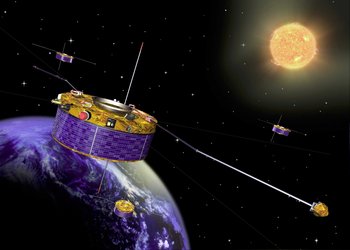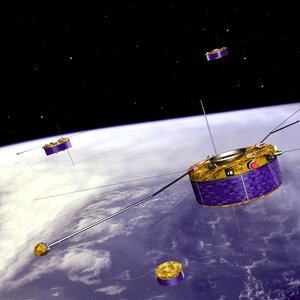Cluster achieves closest-ever separation for two ESA spacecraft
After weeks of careful manoeuvring, Samba and Tango, two of ESA's four Cluster satellites, are now orbiting in formation separated by a mere 17 km - the closest ever that two ESA spacecraft have achieved in routine operations.
The 17-kilometre separation may seem safe enough, but is a mere whisker in cosmic terms. The two spacecraft are travelling approximately 21 600 km/hr with respect to Earth, and, almost seven years after launch, batteries on both spacecraft are well beyond their nominal lifetime and unpredictable battery anomalies have already led three times to unplanned velocity changes.
The close manoeuvring was required to boost the timing and spatial resolution of scientific observations conducted by the four-spacecraft Cluster mission. The identical spacecraft are named Samba, Tango, Rumba and Salsa.
Four-spaceraft fleet in complex 'space ballet'

Before the current manoeuvre campaign, Samba and Tango were separated by 450 km, following each other around the Earth in a polar elliptical orbit varying from roughly 14,000 km to 124,000 km altitude, every 57 hours.
Rumba, Salsa and the closer Samba-Tango pair formed an isosceles triangle in space with a size of 10,000 km. However, this triangle was oriented roughly perpendicularly to the so-called 'neutral sheet,' a region in the Earth's magnetosphere.
At the request of the Cluster scientific community, ESA modified this orientation in order to shift the triangle to be roughly parallel to the Earth's equator inside the neutral sheet.

"The new orientation, with two spacecraft very close, allows scientists to monitor with high spatial resolution very minute fluctuations in the thin neutral sheet, because we perform simultaneously two measurements very close together," says Juergen Volpp, Spacecraft Operations Manager at ESOC, ESA's Space Operations Centre in Darmstadt, Germany.
A series of delicate manoeuvres for both Salsa and Rumba were necessary to achieve this target.
Controllers execute delicate manoeuvres
In order to avoid any risk of collision, Samba was first put into its target orbit, close to but not intersecting that of Tango, in a sequence of three manoeuvres. These manoeuvres also generated a drift that changed the orbit period of Samba between 25 May and 20 June and reduced the separation distance from Tango.

Finally, a small burn of the thrusters on Samba stopped the drift at a distance from Tango of 17 kilometres, coincident with the time that the spacecraft are closest to the Earth.
"The inter-spacecraft distance of 17 kilometres approaches the limit that can be achieved with Cluster, where the four spacecraft are independent. Future missions will need to embark inter-satellite communication systems to achieve even smaller distances," says Detlef Sieg, a flight dynamics expert at ESOC.
This space ballet is another major achievement for the Cluster flight control team at ESOC.
This close separation is not constant along the spacecraft orbits and increases to 40 km when the two are farther from the Earth, in the magneto-tail of the solar wind located on the night side of the Earth, in the thin neutral sheet layer. Investigating the physics of the neutral sheet region is one of the prime objectives of the Cluster mission.
A variety of spacecraft separation distances, together with different constellation orientations, are necessary to fully investigate neutral sheet dynamics and the complex geophysical phenomena that occur there.
"This space ballet is another major achievement for the Cluster flight control team at ESOC. Their contributions have been key to the ongoing scientific success of the Cluster mission," says Philippe Escoubet, ESA Cluster and Double Star project scientist.
The 17-km separation is due to continue at least until 12 July and is the closest that two ESA satellites have ever approached in routine operations. The orientation will enable new scientific discoveries by Cluster, the first space mission to observe the Sun-Earth connection in three dimensions with four identical spacecraft.















 Germany
Germany
 Austria
Austria
 Belgium
Belgium
 Denmark
Denmark
 Spain
Spain
 Estonia
Estonia
 Finland
Finland
 France
France
 Greece
Greece
 Hungary
Hungary
 Ireland
Ireland
 Italy
Italy
 Luxembourg
Luxembourg
 Norway
Norway
 The Netherlands
The Netherlands
 Poland
Poland
 Portugal
Portugal
 Czechia
Czechia
 Romania
Romania
 United Kingdom
United Kingdom
 Slovenia
Slovenia
 Sweden
Sweden
 Switzerland
Switzerland



























